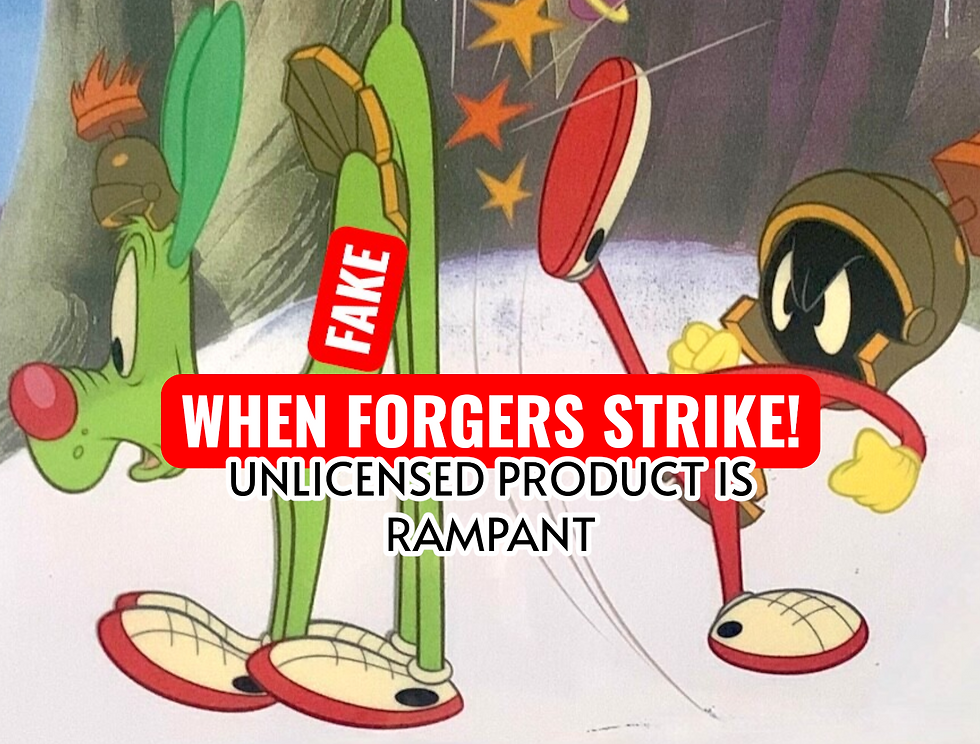What is a Giclée and a Lithograph?
- Animation America

- Feb 3, 2023
- 3 min read
What is a Giclée and a Lithograph?
Giclée is a printing process that uses high-quality, fine-art inkjet printers to produce fine-art reproductions or original prints with high color accuracy, high resolution, and a long lifespan. The term "giclée" is derived from the French word "gicler" which means "to squirt" or "to spray". The process involves using microscopic droplets of pigment-based inks to create prints with smooth transitions, deep, rich colors, and a high level of detail. Giclée printing is often used for fine-art, photographic, and digital art reproductions and is considered to be a high-end printing method.
What is a Litho or Lithograph?
A lithograph is a printing process that creates images by drawing directly onto a flat stone or metal plate using a greasy substance (such as a wax crayon or oil-based ink). The plate is then treated so that the drawn image attracts ink and repels water, and the inked image is transferred to a piece of paper. The process of creating a lithograph involves several steps, including preparing the plate, drawing the image, inking the plate, and pressing the image onto the paper. Lithography is known for its ability to produce high-quality, fine-detail prints and is often used for creating fine art, posters, and commercial products. Lithography is considered one of the traditional printmaking techniques and has a long history dating back to the late 1700s.

What is an Etching?
Etching is a printing process that involves the use of a metal plate, which is first covered with a protective layer and then subjected to an etching process to create a design in the metal. The design is then inked and the plate is pressed onto paper, transferring the ink and creating a print. "AA Etching" specifically refers to a type of etching where the artist creates a design by drawing directly onto the protective layer, rather than first making a separate drawing or engraving the plate. This method is known as "Aquatint Etching," and the term "AA Etching" is often used to refer to prints made using this process. Aquatint etching is known for its ability to create fine tonal variations and can produce delicate, textured prints with a rich, velvety quality.
What is Screen Printing?
Screen printing, also known as silkscreen printing, is a printing technique that uses a stencil, or screen, to apply ink to a substrate, such as paper, fabric, or plastic. The screen is made of a fine mesh material, typically made of nylon or polyester, and is stretched tightly over a frame. The stencil is created by blocking out areas of the screen that will not receive ink, typically using a light-sensitive emulsion or a direct-to-screen process. Ink is then applied to the top of the screen, and a squeegee is used to press the ink through the unblocked areas of the screen and onto the substrate below. Screen printing is often used to produce large quantities of the same image, such as T-shirts, posters, or promotional products, and is known for its ability to print bold, opaque colors and its versatility with a variety of materials. It is also a popular choice for fine art prints due to its ability to create unique textures and printing effects.

What is the Printing process of a poster?
There are several printing processes that can be used to produce a poster, including:
Offset printing: This is a high-volume printing method that uses a plate to transfer ink onto the paper. Offset printing is cost-effective and is often used for printing large quantities of posters.
Digital printing: This is a more recent printing technology that uses a digital file to produce the print. Digital printing is fast and efficient, and can produce high-quality, full-color prints.
Screen printing: This is a traditional printing process that involves pushing ink through a stencil onto the paper. Screen printing is best suited for printing large areas of solid color and is often used for printing posters with simple designs.
Lithography: This is a printing process that uses a flat stone or metal plate to transfer the ink onto the paper. Lithography is known for producing high-quality, fine-detail prints and is often used for printing posters with intricate designs
Till next time, that's all folks!
You can always find us at Animation America







Comments